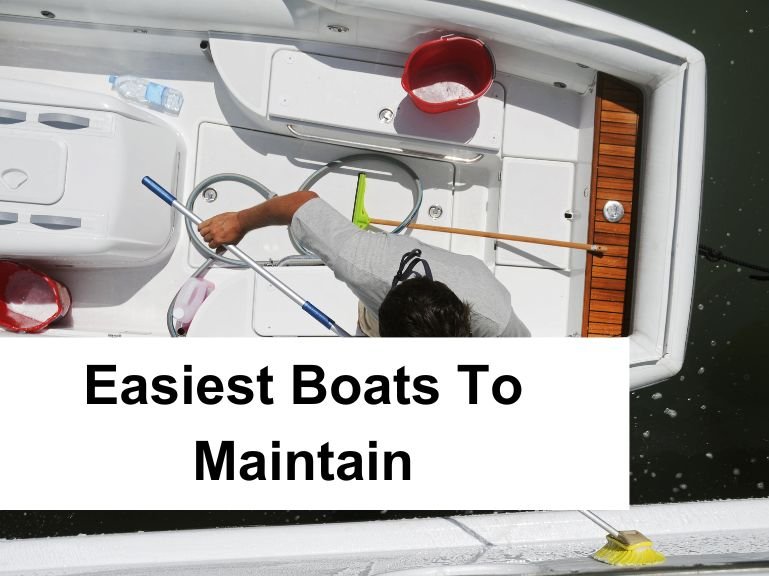The Easiest Boats to Maintain: A Comprehensive Guide
Boating enthusiasts often grapple with the challenge of boat maintenance, a crucial aspect that ensures the longevity and performance of their prized possessions. Opting for a boat that demands minimal upkeep can be a game-changer, especially for those who wish to enjoy the waters without the constant worry of extensive maintenance.

Key Takeaways
The size, material, and propulsion type significantly influence a boat’s maintenance needs.
Specific types of boats like pontoon and Jon boats are inherently low maintenance.
Understanding the factors affecting maintenance can guide better purchasing decisions.
What Makes a Boat Low Maintenance?
When it comes to low maintenance boating, several factors play pivotal roles.
Size Matters: Smaller boats, due to their reduced complexity and amenity count, are easier and more cost-effective to maintain. Their compatibility with simple storage solutions, like garage trailers, also adds to their low-maintenance appeal.
Material Makes a Difference: The majority of today’s recreational boats are crafted from fiberglass, a material celebrated for its maintenance ease and affordability. Notably, fiberglass boats, alongside their aluminum and rotomolded plastic counterparts, require less upkeep compared to traditional wooden boats.
The Role of Propulsion: The maintenance demand of a boat is also significantly influenced by its propulsion system. Outboard engines, for instance, are simpler to care for and replace compared to inboard engines.
Complexity of Systems: A boat’s onboard systems, ranging from electronics to climate control, determine its maintenance needs. The more intricate these systems, the higher the maintenance requirement.
Trim and Surface Care: The amount of maintenance time also depends on the boat’s surfaces. Materials like fiberglass and vinyl demand less care, hence reducing maintenance time.
6 Popular Low Maintenance Boats
Various boat types stand out for their low maintenance needs:
Pontoon Boats: Known for their aluminum hulls and basic systems, these boats are easy to handle and maintain.
Bass & Jon Fishing Boats: Their durable aluminum hulls and trailerability make them low-maintenance options for fishing enthusiasts.
Center Console Fishing Boats: Despite having complex systems for navigation, their simple-to-clean surfaces and outboard engines make them a practical choice.
Deck Boats: These boats, usually under 30 feet, offer ample space and have fuel-efficient hulls, making them low-maintenance.
Bowriders & Runabouts: Ideal for family use, these boats are recognized for their versatility and ease of maintenance.
New Boats: Generally, newer boats demand less upkeep due to their modern design and fewer cosmetic concerns.
Additional Factors Affecting Maintenance
When selecting a low-maintenance boat, several additional factors must be considered:
Material and Maintenance: The boat’s construction material directly impacts its upkeep requirements.
Size and Maintenance: Smaller boats typically equate to less maintenance, owing to their fewer systems and components.
Type and Maintenance: Different boat types, like sailboats and powerboats, come with unique maintenance demands.
Age and Maintenance: New boats usually need less maintenance compared to older, used ones.
Usage Frequency and Maintenance: Boats used more frequently require more regular maintenance.
What Smart Technology Essentials Can Help Maintain Boats Easily?
When it comes to maintaining boats easily, smart technology for boats can be a game-changer. GPS tracking systems can help keep tabs on the boat’s location, while smart sensors can monitor engine performance and alert you to any issues. Automated bilge pumps and smart battery chargers also make maintenance a breeze.
Low Maintenance Boat Options
In the realm of low-maintenance boating, several options stand out:
Fiberglass Sailboats: These boats offer a blend of low maintenance and ease of handling, ideal for those prioritizing minimal upkeep.
Aluminum Powerboats: Celebrated for their durability and corrosion resistance, these boats are a robust, low-maintenance choice.
Inflatable Boats: With simple systems and easy care requirements, these boats are a practical option for occasional boaters.
Pontoon Boats: Known for their simplicity and ease of maintenance, these boats are a favorite among leisure boaters.
Practical Maintenance Tips for Boat Owners
Owning a low-maintenance boat doesn’t mean neglecting care. Here are some practical tips:
Regular Use and Care: Frequent usage ensures that the boat remains in optimal condition, receiving regular attention and care.
Proper Storage: Protecting your boat from the elements, either through covering or proper storage, is crucial in reducing maintenance.
Preventive Maintenance: Adhering to a regular maintenance schedule can prevent major repairs and keep your boat in top condition.
Conclusion
Selecting the easiest boat to maintain hinges on understanding the various factors that influence maintenance requirements. Whether it’s material, size, type, age, or frequency of use, these elements play a critical role in determining the upkeep needed. By choosing a low-maintenance boat that aligns with your needs, you can relish the joys of boating with less worry about ongoing maintenance.
VII. FAQs
Q: What are the most common low-maintenance boat materials? A: Fiberglass and aluminum are widely recognized for their low maintenance requirements.
Q: How does the size of the boat impact maintenance needs? A: Generally, smaller boats require less maintenance due to fewer systems and components.
Q: Are newer boats easier to maintain than older ones? A: Yes, new boats typically require less maintenance as they haven’t experienced wear and tear.
Q: What types of boats require the least maintenance? A: Pontoon boats, aluminum powerboats, and fiberglass sailboats are among the types that require minimal upkeep.
